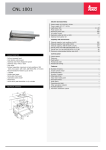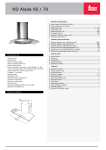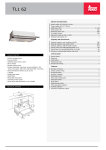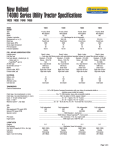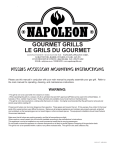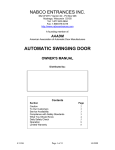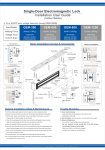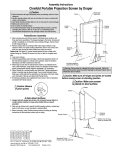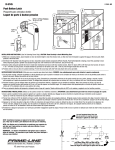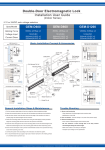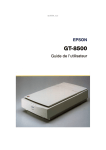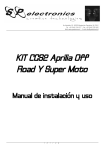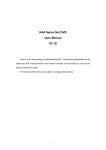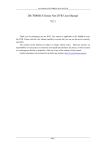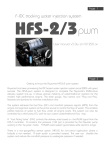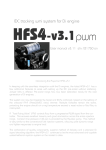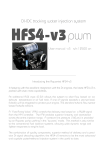Download Gyro Tech Swing Door Conversion Unit
Transcript
S82 W18717 Gemini Drive PO Box 906 Muskego, WI 53150 Phone: (877) 622-2694 Fax: (888) 679-3319 www.nabcoentrances.com Gyro Tech Swing Door Conversion Unit (C.U.) Hardware Installation and Service Manual Bottom Load & Side Load Swing Door Operators Outswing Bottom Load Unit Outswing Side Load Unit Bottom Access Panel Hinged Side Access Panel DN 0270 WARNING Do not install, operate or service this product unless you have read and understand the Safety Practices, Warnings, Installation and Operating Instructions contained in this manual. Failure to do so may result in property damage, or bodily injury. Part # 15-10538 Rev 7-26-07 C.U. Swing Door Operator Installation Manual Table of Contents Page 3.......................................................Cautions Page 4.......................................................Overview and Specifications Page 5.......................................................Header Configurations Page 6.......................................................Handing Requirements Page 7.......................................................List of Materials Page 8.......................................................Installing Bottom Load Header - Steps 1 to 5 Page 9.......................................................Bottom Load Header Installation Diagrams Page 10.....................................................Installing Bottom Load Header - Steps 6 to 7 Page 11.....................................................Installing Bottom Load Header - Steps 8 to 9 Page 12.....................................................Installing Side Load Header - Steps 10 to 14 Page 13.....................................................Installing Side Load Header - Spindle Location Table Page 14.....................................................Installing Side Load Header - Steps 15 Page 15.....................................................Installation of Arms and Tracks - Step 16 Page 16.....................................................Outswing Arm Lengths - Step 17 Page 17.....................................................Arm Pre-load on Analog or Magnum Controlled Units- Step 18 Page 18.....................................................Check Position Adjustments - Analog or Magnum Controls Units- Step 19 Page 19-20 ...............................................Micro Switch Cam Adjustment Illustrations - Analog or Magnum Controls Page 20.....................................................Arm Pre-loading on “U” Series Controlled Units - Step 20 Page 21.....................................................Installing Door Stop, Wiring and Troubleshooting - Steps 21 to 22 Page 22.....................................................NABCO Entrances Return Policy Page 2 www.NabcoEntrances.com 7-26-07 C.U. Swing Door Operator Installation Manual CAUTIONS ! Read all of this First ! Read these safety practices before installing, operating or servicing the automatic door. Failure to follow these practices may result in serious consequences. Read, study and understand the operating instructions contained in or referenced in this manual before operating. If you do not understand the instruction, ask the installing qualified technician to teach you how to use the door. Do not install, operate or service this product unless you have read and understand the Safety Practices, Warnings, Installation and Operating Instructions contained in this manual. Failure to do so may result in property damage, or bodily injury. This manual and the owners’ manual must be given to and retained by the purchasing facility or end user. 1. If the door appears broken or does not seem to work correctly, it should be immediately removed from service until repairs can be carried out or a qualified service technician contacted for corrective action. Never leave a door operating in an unsafe manner. 2. Disconnect power at the fused disconnect during all electrical or mechanical service. When uncertain whether power supply is disconnected, always verify using a voltmeter. 3. All electrical troubleshooting or service must be performed by qualified electrical technicians and must comply with all applicable governing agency codes. 4. It is the responsibility of the installing door technician to install all warning and instructional labels in accordance with ANSI 156.19 & ANSI 156.10 . 5. It is the responsibility of the purchasing facility or end user to keep warning and instructional labels and literature legible, intact and with the door. 6. Replacement labels and literature may be obtained from local NABCO Entrances Inc. distributors. If the name of the local distributor is unknown, contact NABCO Entrances Inc. at 1-877-622-2694 for assistance. 7. Do not place finger or uninsulated tools inside the electrical controller. Touching wires or other parts inside the enclosure may cause electrical shock, serious injury or death. 7-26-07 www.NabcoEntrances.com Page 3 C.U. Swing Door Operator Installation Manual All installation changes and adjustments must be made by qualified, NABCO trained technicians. The purpose of this manual is to familiarize the purchaser with the proper installation and operation of a NABCO surface applied swinger system. It is essential that this equipment be properly installed and operational before the door is used by the public. The installed system must comply with all applicable standards. In the United States, ANSI Standard 156.10 for GT 400 or 8400 (refer to chart below) or ANSI 156.19 for GT 500 or 8500 covers these types of doors. Other local standards or codes may apply. Use them in addition to the ANSI standard. The GT 400 or GT8400 and GT 500 or GT8500 Model Units are listed with Underwriters Laboratory and are identified as such on the label. TO THE INSTALLER Instruct the building owners and operator on the essentials of the operation of the door and this device. The owner should follow these instructions to determine whether the door is operating properly and should immediately call for service if there is any malfunction. OVERVIEW Gyro Tech Swing Door Conversion Unit (C.U.) operators are designed to be installed to the surface of the door frame. The operator is controlled by either the Gyro Tech Magnum or U series microprocessor based controllers or Model 1400 analog control. These controllers offers many features to accommodate most installation options. This manual provides step by step instructions to install the C.U. header and arm assemblies. Refer to your accompanying controller manual for information on wiring and adjusting the controller. Included in the controller manual you will find a trouble-shooting section and optional wiring diagrams. SPECIFICATIONS Models: Conversion Unit Models Base Model Conversion Unit (CU) Bottom Load Conversion Unit (CU) Side Load Model Model Full Automatic (mechanical closer) GT 400 GT 8400 Low Energy (mechanical closer) GT 500 GT 8500 Available controls:............................................................. Model GT-400 or GT-8400 is available with: Magnum, U Series or Analog Control Model GT-500 or GT-8500 is available with: Magnum or Analog Control Only Minimum Frame Face for Mounting.................................. 1 ¾” (44 mm) Minimum Clearance from Top of ..................................... Bottom Load: 6 1/8” (156 mm) Door to Ceiling Side Load: 7 1/8” (181 mm) Door Hinge Requirements ............................................... Butt, Offset Pivot, Center Pivot or Swing Clear Hinges Door Thickness ................................................................ 1 ¾” (44 mm) Minimum Door Width ....................................................................... Specify When Ordering • Use of a supplemental door stop is always required. Page 4 www.NabcoEntrances.com 7-26-07 C.U. Swing Door Operator Installation Manual HEADER CONFIGURATIONS (See Figure 1) The Gyro Tech CU (Conversion Unit) Swing Door Operator is available in two header configurations these are: Bottom Load and Side Load. Bottom load units have an access panel located on the bottom of the housing. Side load units have the access panel located on the side of the unit. Both of these two header types are available for full automatic or low energy systems. Full automatic units are power opened, spring closed. They employ sensors and once adjusted optimally will conform to ANSI 156.10. They are available with Magnum, “U” series or Analog controls. Low energy units are used for barrier free access. They are power opened, spring closed, are usually activated with push button switches and once adjusted optimally will conform to ANSI 156.19. They are available with Magnum or Analog controls. Access Panel Locations Figure 1 GT400 and GT500 Outswing Bottom Load Unit Surface Mount Operator Housing GT400 and GT500 Inswing Bottom Load Unit Surface Mount Operator Housing GT8400 and GT8500 Outswing Sideload Unit Surface Mount Operator Housing Access Panel Hinged Access Panel Access Panel Inswing Arm Outswing Arm and Rod Assembly Surface Mount Track Outswing Arm and Rod Assembly DN 0270 7-26-07 www.NabcoEntrances.com Page 5 C.U. Swing Door Operator Installation Manual HANDING REQUIRMENTS The Figure 2 below illustrate the various methods of handing Figure 2 Left Hand (LH) Inswing Right Hand (RH) Inswing Inswing track Inswing arm EXTERIOR Right Hand (RH) Outswing Left Hand (LH) Outswing Arm mounting bracket Outswing Arm EXTERIOR DN 0270 Note: The hand of the unit must match the hand of the door. To determine the hand of the unit refer to the end flap of the cardboard carton that contains the header housing assembly. Refer also to the serial number stamp on the underside of the operator. The first letter of the serial number will indicate the “hand” of the operator. For example, L2G755640 indicates that the operator is a left hand unit. R2G755640 indicates that the operator is a right hand unit. Refer to Figure 3 below. Figure 3 NABCO ENTRANCES GYRO TECH S82 W18717 Gem ini Drive Mus kego, WI 53150 USA Serial Number L R 579726 Operator serial numbers begins with a letter. The letter not punched out indicates the hand of the operator. For instances, if an “R” is visible, the operator is a Right Hand unit. Page 6 DN 0276 www.NabcoEntrances.com 7-26-07 C.U. Swing Door Operator Installation Manual Below is a table of the major components that comprise a LIST OF MATERIALS GT-400/8400 or GT500/8500 Installation. ITEM 1 ITEM 5 ITEM 3 21-8848 Outswing Arm Assembly ITEM 6 41-8987-01 41-8987-02 LH Operator for U Series Control RH Operator for U Series Control 21-0997 Inswing Track Assy. (12.25”) 21-0998 Inswing Track Assy. (21”) ITEM 4 ITEM 2 21-0902 Inswing Arm. ITEM 11 11-1391 11-1390 LH Clutchless Operator for Magnum Ctrl. RH Clutchless Operator for Magnum Ctrl. LH Operator for Magnum Ctrl. RH Operator for Magnum Ctrl. LH Clutchless Operator for Analog Ctrl. RH Clutchless Operator for Analog Ctrl. LH Operator for Analog Ctrl. RH Operator for Analog Ctrl. 21-3568 21-3570 21-3567 21-3569 OFF AUTO H.O. EXIT OFF AUTO H.O. DN 0145 41-2342 Control, GT300 & GT500 OS - Canada ITEM 7 ITEM 8 ITEM 9 ITEM 10 ON Inswing Arm Assy LH, 204 Inswing Arm Assy LH, 313 Inswing Arm Assy RH, 204 Inswing Arm Assy RH, 313 41-1512 Control, GT300 & GT500 OS - USA ITEM 13 OFF OPEN ON OFF ITEM 14 DOOR OPERATION 41-8987-07 41-8987-08 41-8987-09 41-8987-10 H.O. 41-2208 Control, GT500 Slow Mode - USA 41-3429 Control, GT500 Slow Mode - Canada ITEM 16 ON ON OFF OFF ITEM 12 OFF STOP HOLD-OPEN F1 EXIT AUX PWR TDPG BCHK OPEN TDAS CLOSE RED LCHK Fuse 1: 0.5A 24 VAC LED BLACK SIGNAL INPUT 22-1772-05 Momentary Key Switch J2 10-3528 Rocker Switch HOLD OPEN J1 TRANSFORMER AC IN J4 4 22-11350 Rocker Switch R28 3 22-1772-04 Key Switch 2 22-1772-03 Key Switch O 1 F F 10-3527 Rocker Switch SW2 CURRENT LIMIT MOTOR J5 SW1 CAPACITOR RELAY RELAY F2 Fuse 2:FUSE 3A 120/240 21-9823 Rocker Switch Model/Control Rocker Switch ITEM # DN0033 12-10292 Magnum Control with Brake Module Outsw. Arm Assy. ITEM # Inswing Arm Assy. ITEM # Control ITEM # Motor/Gearbox ITEM # ITEM 15 GYRO TECH - 248901.10 No. MICROPROCESSOR CONTROLLER POWER SOURCE (4P) GT-400 U Series 13 or 14 5 3 + 4 or 6 15 1 GT-400 Magnum 7, 8, 9, 10, or 16 5 3 + 4 or 6 12 2 GT-400 Analog 7, 8, 9, 10, or 16 5 3 + 4 or 6 11 2 GT-8400 U Series 13 or 14 5 3 + 4 or 6 15 1 GT-8400 Magnum 7, 8, 9, 10, or 16 5 3 + 4 or 6 12 2 GT-8400 Analog 7, 8, 9, 10, or 16 5 3 + 4 or 6 11 2 GT-500 Magnum 7, 8, 9, 10, or 16 5 3 + 4 or 6 12 2 GT-500 Analog 7, 8, 9, 10, or 16 5 3 + 4 or 6 11 2 GT-8500 Magnum 7, 8, 9, 10, or 16 5 3 + 4 or 6 12 2 GT-8500 Analog 7, 8, 9, 10, or 16 5 3 + 4 or 6 11 2 7-26-07 MAGNUM IV www.NabcoEntrances.com NO. COLOR 1 2 WHITE 3 BLACK 4 OPERATOR (6P) NO. 1 2 3 4 5 6 COLOR RED ORANGE BROWN BLUE BLACK YELLOW HANDY TERMINAL (6P) USE EMPTY 115VAC COMMON 115VAC HOT EMPTY USE MOTOR V PHASE ENCODER 12VDC ENCODER A PHASE MOTOR U PHASE ENCODER GND ENCODER B PHASE SENSOR (12P) FUSE INSIDE RATING:125V, 4A SIZE:5.2 x 20mm WARNING For continued protection against fire, replace only with same type and rating of fuse. CAUTION USE [SLIDER/SWINGER] 12VDC + 12VDC -,COMMON APPROACH THRESHOLD SENSING /PRESENCE SENSOR REDUCED OPENING /SAFETY MAT ORANGE MODE SW1 ORANGE MODE SW2 ORANGE APPROACH(THROUGH) YELLOW SEQUENTIAL BREAK OUT BLUE VIOLET OUTPUT + GRAY OUTPUT - NO. SYMBOL COLOR 1 9DC12V BROWN 2 7 RED 3 61 BLACK 4 6B WHITE 5 H 6 7 8 9 10 11 12 M0 M1 62 SQ BA OUT + OUT - GREEN 1.Please adjust this operator as per instruction manual. 2.Turn the power off, before opening the box. 3.Don't open this box except for replacing fuse. Otherwise, the warranty will be terminated. 4.Repair of this unit except by Nabco Entrances, Inc. may cause software and hardware malfunction. 24-8901 U Series Control Page 7 C.U. Swing Door Operator Installation Manual INSTALLATION: Steps 1 to 9 Bottom Load Steps 10-15 Side Load Unit Steps 16-22 Both BOTTOM LOAD ONLY Step 1 - Remove material from packages and check contents: Remove all contents from the carton. Check all items to ensure you have the material you need before beginning the actual installation. Step 2 - Remove access panel from header housing assembly: Carefully remove the header housing assembly from the cardboard carton. Using a Phillips screwdriver, remove the Access Panel (see Fig 1 on page 5). Use a pencil to mark the locations of the Access Panel Mounting Brackets. This will make it easy to place the brackets back in the correct position when re-installing the Access Panel. Refer to Figure 5 below. Mark the location of the Access Panel Mounting Brackets with a pencil Note that when reinstalling the brackets, that the tabs on the brackets should be facing downward. Figure 5 Step 3 - Remove paperwork: DN 0078 Remove all decals, paperwork and parts bag from inside header and set to one side. Step 4 - Install wiring in frame: All conduit and switch or sensor wires must be pulled through the frame or wall before mounting the operator housing. Refer to your separate Controller Installation Manual for wiring instructions. Step 5 - Mount header housing assembly on door frame: Refer to figures on next page. The following instructions refer to mounting the unit on aluminum framing. If the unit is not being installed on an aluminum frame then adequate structural framing must be available for mounting. Note: There is a difference in the location of the operator spindle between inswing and outswing header housing assemblies. Therefore the width of the base pivot plate on which the operator is mounted is varied according to the type of door; inswing, outswing, with or without finger guard, etc. Refer to Figure 7 Page 9. To ensure you are matching the correct header housing to the door you are working on, refer to the table on the above mentioned page. Once all wiring is in place, using the empty header mounting brackets as a template, hold the header against the frame, and mark the mounting holes on the jamb tubes as shown on the following page. Ensure bottom of header housing assembly is 1-1/8” up from the top of the door as shown in Figure 6 on Page 9. The center line of the three holes on the end mounting brackets must be located one (1) inch away from the edge of the door frame as shown. NABCO recommends the use of Rivnuts when mounting the header to aluminum framing. Using a #Q sized drill bit (0.332 DIA), drill out the four holes per bracket in the jamb tubes and countersink the holes 0.531 DIA x 100o and insert the supplied Rivnuts. Using a Rivnut setting tool, expand the Rivnuts in the aluminum frame until they are “snug”. Caution! Over tightening the Rivnuts will cause the threads to strip. Once all holes are properly drilled and Rivnuts installed, mount header housing to frame using the six 1/4-20 x 1” flat header screws provided. Affix the tape onto the end caps and mounting brackets to cover the mounting screws and end cap screws. NABCO recommends the use of Rivnuts when mounting the header to aluminum framing. On other types of installations such as hollow metal door frames, adequate backing such as 2” x 10” wood backing is required above the top of the frame for anchoring the header housing to the wall. Using this method would require lag bolts instead of 1/4 x 20 Rivnuts to properly anchor the unit. Page 8 www.NabcoEntrances.com 7-26-07 7-26-07 Figure 6 A = Base Plate dimension B = Spindle Location B A www.NabcoEntrances.com Butt/Offset Center Pivot Butt/Offset Center Pivot GT-400 GT-500 Notes: N/A = Not Applicable Pivot Type Model N/A 6" N/A 3-1/2" 5" 5" 2-1/2" 2-1/2" A N/A 6" N/A 3-1/2" 5" 5" DN 0270 DN 0270 Figure 8 Rivnuts must be used to secure housing to aluminum framing. Mark holes for mounting screws. Drill out holes and securely fasten to structural framing. Base Plate varies with door configuration (refer to chart below) Figure 7 2-1/2" 2-1/2" Outswing With Fingerguard No Fingerguard B A B A Spindle Loc. Base Plate Spindle Loc. Base Plate N/A N/A 7-1/4" 4-3/4" 8-1/4" 5-3/4" 7-1/4" 4-3/4" Spindle Locations and Base Pivot Plate Sizes Inswing With Fingerguard No Fingerguard B A B A Spindle Loc. Base Plate Spindle Loc. Base Plate N/A N/A 5" 2-1/2" 6" 3-1/2" 5" 2-1/2" C B Position the end of the housing assembly to line up with the inner edge of the jamb tube (on the pivot side) as shown. 1-1/8” between top of door and underside of housing assembly. Note: this dimension is to accommodate INSWING units. Outswing units can be lowered provided the arm has an appropriate place to mount on the top rail of the door. 1" from inner edge of pivot jamb to center line of holes Note: The illustrations on this page depict an installation to an aluminum door and frame. On other types of installations such as hollow metal door frames, adequate backing such as 2” x 10” fir or spruce to provide structural framing is required above the top of the frame for anchoring the header housing to the wall. Using this method would require lag bolts instead of 1/4 x 20 Rivnuts to properly anchor the unit. DN 0270 Drill 25/64” diameter holes in jamb tube and insert Rivnuts for affixing housing assembly to aluminum framing or securely fasten to structural framing BOTTOM LOAD ONLY C.U. Swing Door Operator Installation Manual Page 9 C.U. Swing Door Operator Installation Manual BOTTOM LOAD ONLY Step 6 - Install wires in header housing assembly: Bring wires into housing assembly from lock side of header if possible since this is the side that is closest to the controller. Wires can be routed through the knockouts located at either end on the top of the header assembly. Using the supplied metal clips, route all loose wires through channels in header housing assembly and snap into place in channel as illustrated in Figure 10 below. Step 7 - Install stop ring on operator: Refer to Figure 9 below. Once all wires are in place, the operator and controller can be mounted in place in the header housing assembly. Place operator on bench with the underside facing up as shown in Figure 9. Remove the Stop Ring Assembly from the plastic bag and it install on the operator using the supplied brackets and the (4) 5/16-18 FL. HD. Soc. Mach. Screws. Do not tighten the screws all the way down until the operator is installed in the header housing assembly and the arm is installed. Stop Ring Figure 9 Front Mount Pins Serial Number Front Mounts DN 0276 Rear Mount Lovejoy coupling access hole for bottom load operators. Acc Stop Ring Brackets A similar hole is located on the top side of the operator for side load units also. es s pan el re mov ed f or c larity Figure 10 Wire Harness Snap Clip In Place Controller Mounting Clip Steel clip DN 0270 Access Panel to Housing Assembly Page 10 www.NabcoEntrances.com 7-26-07 C.U. Swing Door Operator Installation Manual BOTTOM LOAD ONLY Step 8 - Install operator in header housing assembly: If installing Analog control it might be necessary to mount a soft start capacitor on the operator prior to installing it in the header housing assembly. Refer to your Controller Installation Manual for additional information. Using a 9/16” deep socket and ratchet, remove the nuts and washers from the operator mounting bracket inside the header housing assembly. Place them on the top of the installed header housing assembly for easy reach. Holding the operator at an angle as shown in Figure 11 below, slip the operator Front Mounts over the pins and the Rear Mounts over the operator mounting brackets. Holding the operator up in place, install the two 9/16” flat washers and nuts on to the mounting bracket studs and tighten securely. Figure 12 illustrates an installed operator. Once installed, the operator spindle should be located at the correct distance from the jamb as shown in the dimensions chart on page 9. Figure 11 Figure 12 Tabs on the brackets should be pointing downward. Front Mounts on operator cover Pivot Base Tabs NABCO ENTRANCES INC. R3J724456 DN 0270 Ensure that the switch harness is tucked between housing assembly and operator mounting bracket DN 0270 Step 9 - Install control mounting clip and controller: Snap controller mounting clip into housing extrusion and then snap control into mounting clip. Refer to figure 10 & 13. Note: Magnum or “U” series controls used on simultaneous pairs require two controls and mounting clips. . Figure 13 U Series Control Controller Mounting Clip DN 0140 Magnum Control DN 0139 7-26-07 www.NabcoEntrances.com Page 11 C.U. Swing Door Operator Installation Manual INSTALLATION: SIDE LOAD ONLY Steps 1 to 9 Bottom Load Steps 10-15 Side Load Unit Steps 16-22 Both Step 10 - Remove material from packages and check contents: Remove all contents from the carton. Check all items to ensure you have the material you need before beginning the actual installation. Refer to Figure 4 for an illustration of the components that make up a typical C.U. system. Step 11 - Remove access panel from header housing assembly: Carefully remove the header housing assembly from the cardboard carton. Using a Phillips screwdriver, remove the two Access panel retaining screws, refer to Figure 14 on the following page. Step 12 - Remove paperwork: Remove all decals, paperwork and parts bag from inside header and set to one side. Step 13 - Install wiring in frame: All conduit and switch or sensor wires must be pulled through the frame or wall before mounting the operator housing. Refer to your separate Controller Installation Manual for wiring instructions. Step 14 - Mount header housing assembly on door frame: Refer to Figure 14 on next page. The following instructions refer to mounting the unit on aluminum framing. If the unit is not being installed on an aluminum frame then adequate structural framing must be available for mounting. Once all wiring is in place, drill two or three 1/4” holes through the back of the header housing to securely mount in place. These holes will be used to mount the header housing to the jambs. Wires can be routed out through the face of the jamb and into the back of the header housing. Alternatively, the unit can be ordered with knockouts located at either end on the top of the header assembly that can be used to route wires into. Note: It might be necessary to remove the operator and motor assembly from the housing to reduce the weight of the unit while positioning the unit on the frame to be mounted. Note: There is a difference in the location of the operator spindle (on which the arm is mounted) between inswing and outswing header housing assemblies. Therefore, the position of the operator spindle is varied according to the type of door, be it inswing, outswing, with or without finger guard, etc. To ensure you are matching the correct header housing to the door you are working on, refer to the table titled “GT-8400 and GT-8500 - Spindle Locations” on the following page. Once holes are drilled, position the header housing on door frame so that the bottom of the header housing assembly is located 1-1/8” up from the underside of the door frame as shown in Figure 14. Using a pencil, scribe the holes for drilling the jamb tube. Remove header housing. Using the penciled circles for guides, drill the jamb tubes using a #Q sized drill bit (0.332 DIA), and countersink the holes 0.531 DIA x 100º. Insert the supplied Rivnuts. Using a Rivnut setting tool, expand the Rivnuts in the aluminum frame until they are “snug”. Caution! Over tightening the Rivnuts will cause the threads to strip Once all holes are properly drilled and Rivnuts installed, mount header housing to frame using the six 1/4-20 x 1” flat header screws provided. NABCO recommends the use of Rivnuts when mounting the header to aluminum framing. On other types of installations such as hollow metal door frames, adequate backing such as 2” x 10” wood backing is required above the top of the frame for anchoring the header housing to the wall. Using this method would require lag bolts instead of 1/4 x 20 Rivnuts to properly anchor the unit. Page 12 www.NabcoEntrances.com 7-26-07 7-26-07 Note: Rivnuts must be used to secure housing to aluminum framing. Figure 14 www.NabcoEntrances.com Notes: N/A = Not Applicable Center Pivot Butt/Offset 6" N/A 6" Center Pivot GT-8500 N/A Butt/Offset 5" 5" 5" 5" Spindle Loc. Spindle Loc. GT-8400 No Fingerguard 6" N/A 8-1/4" N/A Spindle Loc. 5" 5" 7-1/4" 7-1/4" Spindle Loc. No Fingerguard Outswing With Fingerguard Dimension “B” 1-3/4” Standard Overlap 1-1/8” between top of door and underside of housing assembly. Note: this dimension is to accommodate INSWING units. Outswing units can be lowered provided the arm has an appropriate place to mount on the top of the door. Door Stop Access panel retaining screw Drill 1/4” holes through back of housing to securely mount header. Position housing on door frame and, using a pencil, mark holes for drilling jamb tube behind. Remove housing and using marked holes for guides, drill 0.332” diameter holes through jamb tube. Insert and expand Rivnuts into jamb tubes and mount housing on frame as shown. If mounting to a wall, adequate backing is required for bolting the unit tot he wall. Use lag bolts or a similar system for anchoring. Position the end of the housing assembly to line up with edge of the 1-3/4” jamb tube (on the pivot side) as shown. With Fingerguard Pivot Type Inswing “B” Spindle location dimension varies with door configuration Model GT-8400 and GT-8500 - Spindle Locations DN 0279 Coupling Access Hole Side Load Header Only SIDE LOAD ONLY C.U. Swing Door Operator Installation Manual Page 13 C.U. Swing Door Operator Installation Manual SIDE LOAD ONLY Step 15 - Install operator in header housing assembly (if removed): Position operator and motor assembly inside header housing assemble and secure from the bottom with four (4) 5/16-18 flat head screws as shown in Figure 15 below. Once installed, the operator spindle should be located at the correct distance from the jamb as shown in the dimensions chart on page 13. Figure 15 Secure operator through underside of housing with four (4) 5/16-18 flat head screws supplied. Auxiliary Door Stop DN 0279 Page 14 www.NabcoEntrances.com 7-26-07 C.U. Swing Door Operator Installation Manual Step 16 - Installation of Arms and Tracks: (ALL MODELS) On outswing doors, remove the arm mounting bracket (refer to Figure 2 page 6) from the outswing arm assy. and install on door as shown below. On inswing units, remove the inswing track (refer to Figure 2 page 6) from box and install on door as shown below (do not install the arm on to the operator spindle at this time). Dimension "C" - Outswing Arm Mounting Locations Distance From Inside Edge of Pivot Jamb to Center Line of First Arm Bracket Mounting Hole Outswing Model Pivot Type With Fingerguard No Fingerguard GT-400 & GT-8400 Butt/Offset Center Pivot Not Applicable 16" 12-7/16" 15" GT-500 & GT-8500 Butt/Offset Center Pivot Not Applicable 13-3/4" 10-3/16" 12-3/4" Attach arm bracket to door using 1/4" - 20 F.H.M.S. (use Rivnuts or Nutserts or reinforce door) Operator spindle Bottom load header shown, same for side load 1-1/8" from top of door to bottom of housing assy. 1-1/2” Dimension B Dimension C DN 0270 Dimension "C" - Inswing Track Mounting Locations Distance From Inside Edge of Pivot Jamb to Center Line of First Mounting Hole Model GT-400 & GT-8400 Inswing Standard Track (ST) 11-1/4" With Fingerguard No Fingerguard Pivot Type Butt/Offset Center Pivot GT-500 & GT-8500 Butt/Offset Center Pivot Inswing Panic Track (PT) 20-1/16" With Fingerguard No Fingerguard Not Applicable 8-1/4" Not Applicable Not Applicable 13" 12" 3-3/4" 2-3/4" Not Applicable 8-1/4" Not Applicable Not Applicable 13" 12" 3-3/4" 2-3/4" Attach arm bracket to door using 1/4" - 20 F.H.M.S. (use Rivnuts or Nutserts or reinforce door) Bottom load header shown, same for side load Dimension B 1-1/8" from top of door to bottom of housing assy. Dimension C 11/16” if using straight arm for 0” reveal 1-9/16” if using “L” shaped arm for all other reveals DN 0270 7-26-07 www.NabcoEntrances.com Page 15 C.U. Swing Door Operator Installation Manual Step 17 - Outswing Arm Lengths: Using the chart below, determine the appropriate length of the outswing arm (dimension “D”) and cut the supplied threaded rod to suit. Measure and cut the supplied plastic arm cover to suit rod length and slide over threaded rod. Assemble arm as shown in Figure 16 below. Figure 16 (Plan View) Determining Dimension “D” Door Frame Arm Reveal (distance from face of door to back side of housing assembly) Housing Assembly (Bottom Load shown) “D” DN 0270 Dimension “D” Outswing Arm Length Distance from Center Line of Arm Elbow to Center Line of Bolt on Door Bracket Reveal Model Pivot Type 1-1/8” 2-1/8” 3-1/8” 4-1/8” 5-1/8” 6-1/8” GT-400 & GT-8400 Butt/Offset 11-7/8” 12-7/8” 13-7/8” 14-7/8” 15-7/8” 16-7/8” Center Pivot 12-1/2” 13-1/2” 14-1/2” 15-1/2” 16-1/2” 17-1/2” Butt/Offset 11-7/8” 12-7/8” 13-7/8” 14-7/8” 15-7/8” 16-7/8” Center Pivot 11-7/8” 12-7/8” 13-7/8” 14-7/8” 15-7/8” 16-7/8” GT-500& GT-8500 Page 16 www.NabcoEntrances.com 7-26-07 C.U. Swing Door Operator Installation Manual Step 18 - Arm Pre-load on Magnum or Analog Controlled Units: (if installing a unit with a “U” series microprocessor skip to Step # 20) Refer to Figures 17 & 18 below. In order to achieve correct back check and latch positions, the operator must be preloaded (spring wound up before the arm is affixed to the door) by approximately 130 - 140 º. This also rotates the cams (located on the top of the operator) around to the required position to open and close the micro switches at the correct point of door travel. With door closed and arm connected to the door, the scribe mark on the underside of the operator spindle should be parallel with the door. To properly pre-load operator and set arm in correct location on spindle, perform the following steps: a. Be certain operator/motor is plugged into controller. ! WARNING ! The controller has an electrical circuit built in to slow the rotation of the operator arm while it is unwinding. Removing the pin while the motor is unplugged from the controller will allow the spindle and arm to unwind at high speed and can result in personal injury or damage. Great care must be taken not to dislodge pin or otherwise release the operator and arm unless the motor is properly plugged in to the controller. b. c. d. e. f. g. h. With the operator fully unwound and the arm uninstalled, the position of the micro switch cam would be as shown in Figure 19 on the following page. Install the arm on the operator spindle in the unwound position. While tightly holding the arm, wind up the operator approximately 60 degrees. On bottom load units, insert a 1/8” Allen wrench or similar tool into the Lovejoy coupling access hole located on the bottom of the operator at the motor end. Refer to Figure 9. On side load units, insert a 1/8” Allen wrench or similar tool into the Lovejoy coupling access hole located on the top of the operator at the motor end. Refer to Figures 9 and 14. This will pin the motor and operator in the correct position and prevent them from unwinding. Remove the arm, rotate it “minus” 60 degrees and reinstall it again. While holding arm, remove pin, wind up the spindle 60 degrees again and re-pin the operator. Repeat this process in increments of approximatley 60 degrees to achieve the necessary fully loaded position of 130-140 degrees. It might be possible to wind the arm more than 60 degrees at a time, if so, that is acceptable. Inspect scribe mark on the underside of the spindle. With door closed and arm connected to the door, the scribe mark on the underside of the operator spindle should be parallel with the door. Once item (f) is confirmed, tighten set screw on the arm. Ensure the set screw on the arm is seated correctly in the groove on the operator spindle. Refer to Figure 23 on page 21. Once the arm is connected to the operator spindle, connect the other end of the arm to the door bracket or track. Note: the easiest way to install the inswing arm into the track is to remove the 1/4”-20 screw from one end of the track and let it swing down. Allow the roller to contact and push againist the door and then swing the track back up so that the roller is inside the track and re-install the screw. Figure 17 Pre-loading a LH Inswing Operator Arm in Unwound Position 70-80° 60° Figure 18 Pre-loading a RH Outswing Operator Wind arm in 60º increments Arm in Wound Position Arm in Unwound Position Bottom Load Housing Assy. Shown 70-80° Arm in Wound Position 60° Wind arm in 60º increments DN 0270 7-26-07 www.NabcoEntrances.com Page 17 C.U. Swing Door Operator Installation Manual Figure 19 Position of the adjustment cam in the fully unwound position on left and right hand operators. Magnum or Analog Controlled Units Only Latch Check Switch Wires Magnum Control: White & Green Analog Control: Orange & Brown Figure 19 Position of cam on LEFT Hand operator shown with spring FULLY UNWOUND Back Check Switch Wires Magnum Control: Red & Blue Analog Control: Yellow, White & Blue Back Check Switch Wires Magnum Control: Red & Blue Analog Control: Yellow, White & Blue Position of cam on RIGHT Hand operator shown with spring FULLY UNWOUND Latch Check Switch Wires Magnum Control: White & Green Analog Control: Orange & Brown DN 0270 Step 19 - Check Position Adjustments on Analog or Magnum Controlled Units: Once the unit is mounted, the operator, control and arm is installed and the other half of the arm affixed to the door, the door can be used manually. To verify correct operator pre-load or check/change the desired position at which the door will go into back check and latch check, apply power to the units taking care to correctly connect the 120 VAC as outlined in the controller installation manual. Activate the unit. The door should go open, time out and close smoothly. If adjustment of check positions are required, perform the following steps: On a GT-400/500 Bottom Load Conversion Unit (CU): Only the back check cam is adjustable on a bottom load unit. Refer to Figure 20 on the following page. The cam assembly can be adjusted through an access hole located on the top of the header housing. Remove the plastic snap in cover and observe the micro switches and cam on the top of the operator. The position at which the door is switched into back check can be varied by rotating the cam shown in Figure 20. The rotation of this cam is adjustable by removing the black “set screw” and placing it in the adjustable position as shown. Then, by loosening the “cam hold down screw” and rotating the cam, the point at which the door is switched into back check can be varied (this applies to Magnum or Analog controlled systems only – the U series microprocessor does not use switches to control back check and latch positions). On a GT-8400/8500 Side Load Conversion Unit (CU): Refer to Figure 21 on the following page. The cam assembly must be accessed from inside the header housing assembly. Using a 5/16” box or open end wrench, loosen the cam hold down screw. Using a 1/4” open ended wrench, loosen the cam set screw and rotate the top cam to adjust the back check position or the bottom cam to adjust the latch check position. This applies to Magnum or Analog controlled systems only. The U series microprocessor does not use switches to control back check and latch positions. Note: Both the back check and the latch check positions can be varied. Page 18 www.NabcoEntrances.com 7-26-07 C.U. Swing Door Operator Installation Manual Bottom Load Unit Only - Adjustment of Back Check Cam is made with Phillips Screwdriver from TOP of the Header Magnum or Analog Controlled Units Only The illustration below shows the procedure for repositioning the cam set screw to vary back check positions. To adjust, insert screw driver from top and loosen screws. Cam set screw with Phillips head in fixed factory position Figure 20 Short arm panic breakout micro-switch Set screw is moved here for the adjustable position Cam hold down screw with Phillips head DN 0275 Back check and Latch check Micro-switches DN 0274 Side Load Unit Only - Adjustments of Back and Latch Check Cams are made with Wrench from SIDE of the Header Magnum or Analog Controlled Units Only The illustration below shows the procedure for repositioning the cam set screw to vary back check and latch check positions. To adjust, insert wrench from side and loosen screws. Set screw with 1/4” Hex Head located in adjustable position Figure 21 Short arm panic breakout micro-switch Cam hold down screw with Hex head DN 0273 need a new picture from John. change this illustration. Back check and Latch check Micro-switches DN 0271 Notes: The Latch Check and Back Check switches illustrated above are not used with the “U” Series control. The short arm micro-switch is a panic breakout switch used on all inswing units. 7-26-07 www.NabcoEntrances.com Page 19 C.U. Swing Door Operator Installation Manual (Magnum or Analog controls only) Figure 22 below illustrates the correct position of the switch cams in the door CLOSED and door OPENED positions with the operator pre-loaded 130º - 140º. Figure 22 Back Check Switch Breakout Switch Right Hand operator shown in DOOR CLOSED position. Latch Check Switch ACUGARD limit switch (if used) Back Check Switch Breakout Switch Right Hand operator shown in DOOR OPENED position. Latch Check Switch Latch Check Switch Left Hand operator shown in DOOR CLOSED position. Back Check Switch Breakout Switch Latch Check Switch Left Hand operator shown in DOOR OPENED position. Back Check Switch Breakout Switch DN 0277 Step 20 - Arm Pre-loading on “U” Series Controlled Units: The NABCO “U” Series Control keeps track of the door’s position via the motor encoder. Therefore the degree of preload is not as crucial as with the Magnum or Analog control. The degree of pre-load on the operator arm is at the discretion of the installer. More pre-load can be applied when more closing force is desired. Once the control is powered up and the door is programmed for stroke via the Handy Terminal, the position of the door and arm is saved in the memory of the U Series Controller. To install the arm on the spindle, perform the following steps: a. Be certain operator motor is plugged into controller. ! WARNING ! The controller has an electrical circuit built in to slow the rotation of the operator arm while it is unwinding. Unplugging the operator from the controller once the arm is wound up will allow the spindle and arm to unwind at high speed and can result in personal injury or damage. Page 20 www.NabcoEntrances.com 7-26-07 C.U. Swing Door Operator Installation Manual b. For minumum door closing force: Install the arm on the operator spindle with a 45 degree pre-load. Install and connect control as Controller Installation Manual and program door stroke. Ensure the set screw on the arm is seated correctly in the groove on the operator spindle. Figure 23 Operator and Motor Assembly Ensure that set screw on arm is seated in groove on operator spindle Arm Assembly DN 0270 Step 21- Install door stop: On Side Load Units, open door to the full open point and position door stop shown in Figures 14 & 15 so that it butts against the arm. Using a pencil mark the hole positions. Drill and tap for 1/4” - 20 bolts. Secure arm stop to underside of housing with two (2) 1/4” - 20 round head screws supplied. On Bottom Load Units, loosen stop ring brackets shown in Figure 9 on page 10, open door to the full open point and rotate the door stop so that it butts against the arm and tighten stop ring bracket retaining screws. Step 22 - All units - Install wiring, and sensors as per the separate Controller Installation manual. TROUBLE SHOOTING Symptom Operator does not function. Action/Cause Door is staying open on activation Spring is broken in the operator Replace spring Door slams closed. Clutch gear or woodruff keys slipping in operator Replace operator Motor spins on activation but door does not open Check polarity of motor input wires at connector on motor. Reverse motor leads. Door begins to open then closes suddenly Clutch gear or woodruff keys slipping in operator Replace operator Door does not stay tightly closed. 1. Preload on swing arm is not correct. 2. Building stack pressure excessive. 7-26-07 Solution 1. Gears slipping or binding in operator or coupling slipping between motor and operator 2. Motor is plugged in backwards 1. Re-secure or free up gears or couplings 2. Reverse motor leads 1. Set pre-load on arm as explained on page 17 2. Replace clutched operator with clutchless operator www.NabcoEntrances.com Page 21 C.U. Swing Door Operator Installation Manual NABCO Entrances Return Policy - Limited Warranty NABCO ENTRANCES INC. for its Gyro Tech product line, provides to its distributor a limited warranty, on Gyro Tech products. This warranty is: NABCO ENTRANCES INC. will exchange or repair, F.O.B. the plant, any component found defective in workmanship and/or material, subject to Nabco’s inspection, for a period of one (1) year after installation or 18 months after manufacture, whichever comes first. Warranty does not include field service labor. The installing contractor/distributor will be responsible for installation and field service. This is NABCO ENTRANCES Inc.’s sole warranty. This warranty does not cover loss or damages resulting from causes beyond the manufacturer's control, misuse, neglect, accidents, windstorms, or other acts of God, or acts of terrorism. Warranty is for normal use and service. The warranty does not apply to equipment that has been repaired or altered so as to adversely affect conditions of operation. Warranty will not obligate NABCO for damages resulting from such alterations, misuse, or acts of God, or acts of terrorism. Extended Warranties - New Parts and Equipment Only Two-year warranties on all Gyro Tech entrance systems are available. The two (2) year warranty is the same as the one (1) year warranty except for a period of two (2) years after installation or 30 months after manufacture whichever comes first. All orders requesting a multi year warranty must be included on the purchase order at the time of the original order to establish proper records. Any other extended warranty must be specifically approved and priced by NABCO Management. Warranty Seal on Operators All operators will contain a warranty seal placed over the cover and housing. The warranty will become invalid if any operator is returned with the seal broken. Return of Warranty Parts NABCO must be promptly notified (within 2 weeks of failure) of all warranty claims. All parts for warranty claims must be returned to NABCO within the following two (2) weeks for US locations and six (6) weeks for all other locations. All parts must be returned freight prepaid and include a Return Material Authorization Tag/Number which is available by contacting the Customer Service Department. All items returned are subject to inspection and testing to determine the cause of failure. If in NABCO's determination: A. For all items, when the part returned is defective and within the terms of the warranty, it will be repaired or replaced. Any repaired item would carry the full warranty from original installation date. If the piece has been replaced, a credit memo will be issued against the replacement invoice. Warranty parts are shipped prepaid via ground transportation by Nabco. Expedited delivery costs are paid by the distributor. B. For all items, if it is determined the part returned is not defective and within the terms of the warranty the part will remain the property of the Distributor at the time of this determination. The disposition of the item will be agreed upon with the distributor. The only options considered will be: 1. 2. 3. To return the item at the distributor cost. To return it to stock less inspection and testing costs if the piece has not been used and remains saleable as a new part. A 20% restocking charge will apply and be paid by the distributor. Discarded by NABCO. Non-warranty Returns Applications for the return and credit of any parts item must be made in writing to Nabco Customer Service within 60 days of the date of our shipment. Only items listed on attached Nabco RMT tags will be considered. Parts that have been ordered incorrectly can be exchanged for the correct items provided Nabco Customer Service is notified in writing within 60 days of the date of our shipment and subsequent return authorization has been given. Credit for parts that have been ordered by the distributor and are no longer needed for repair in the field will be subject to the discretion of Nabco. A 20% stocking fee will apply. END. Page 22 www.NabcoEntrances.com 7-26-07






















